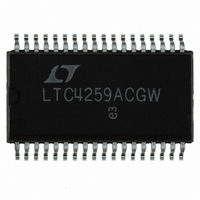LTC4259ACGW#PBF Linear Technology, LTC4259ACGW#PBF Datasheet - Page 17

LTC4259ACGW#PBF
Manufacturer Part Number
LTC4259ACGW#PBF
Description
IC CTRLR POE QUAD AC DISC 36SSOP
Manufacturer
Linear Technology
Datasheet
1.LTC4259ACGW.pdf
(32 pages)
Specifications of LTC4259ACGW#PBF
Controller Type
Power over Ethernet Controller (POE)
Interface
I²C
Voltage - Supply
3 V ~ 4 V
Current - Supply
2.5mA
Operating Temperature
0°C ~ 70°C
Mounting Type
Surface Mount
Package / Case
36-SSOP
Lead Free Status / RoHS Status
Lead free / RoHS Compliant
Available stocks
Company
Part Number
Manufacturer
Quantity
Price
APPLICATIO S I FOR ATIO
measures the port voltage through the DETECT n pin. Note
that class 4 is presently specified by the IEEE as reserved
for future use. Figure 14 shows a PD load line, starting with
the shallow slope of the 25k signature resistor below 10V,
then drawing the classification current (in this case, class 3)
between 14.5V and 20.5V. The LTC4259A’s load line for
classification is also shown in Figure 14. It has low imped-
ance until current limit at 65mA (typ).
The LTC4259A will classify a port immediately after a
successful detection cycle in Semiauto or Auto modes, or
when commanded to in Manual mode. It measures the PD
classification signature current by applying 18V (typ) to
the port and measuring the resulting current. It reports the
detected class in the Class Status bits in the correspond-
ing Port Status register. Note that in Auto mode, the port
will power up regardless of which class is detected.
The classification circuitry is disabled when the port is in
Shutdown mode, powered up, or the corresponding Class
Enable bit is cleared.
POWER CONTROL
The primary function of the LTC4259A is to control the
delivery of power to the PSE port. It does this by control-
ling the gate drive voltage of an external power MOSFET
while monitoring the current via a sense resistor and the
output voltage at the OUT pin. This circuitry serves to
couple the raw isolated –48V input supply to the port in a
controlled manner that satisfies the PD’s power needs
while minimizing disturbances on the –48V backplane.
60
50
40
30
20
10
0
0
Figure 14. PD Classification
5
U
PD LOAD
TYPICAL
CLASS 3
VOLTAGE (V
LINE
10
U
CURRENT
CLASS 4
CLASS 3
OVER
CLASS 2
CLASS 1
CLASS 0
CLASS
15
)
PSE LOAD LINE
W
48mA
33mA
20
23mA
14.5mA
6.5mA
4259A F14
25
U
Gate Currents
Once the decision has been made to turn on power to a
port, the LTC4259A uses a 50µA current source to pull up
on the GATE pin. Under normal power-up circumstances,
the MOSFET gate will charge up rapidly to V
threshold voltage), the MOSFET current will rise quickly to
the current limit level and the GATE pin will be servoed to
maintain the proper I
put charging is complete, the MOSFET current will fall and
the GATE pin will be allowed to continue rising to fully
enhance the MOSFET and minimize its on resistance. The
final V
50µA current source pulls down on the GATE pin, turning
the MOSFET off in a controlled manner.
No External Capacitors
No external capacitors are required on the GATE pins for
active current limit stability, lowering part count and cost.
This also allows the fastest possible turn-off under severe
overcurrent conditions, providing maximum safety and
protection for the MOSFETs, load devices and board traces.
Connecting capacitors to the external MOSFET gates can
adversely affect the LTC4259A’s ability to respond to a
shorted port.
Inrush Control
The 802.3af standard lists two separate maximum current
limits, I
ues, the LTC4259A implements both as a single current
limit using V
differentiated through the use of t
tively (see t
maintain consistency with the standard, the I
is used when referring to an initial t
When the LTC4259A turns on a port, it turns on the
MOSFET by pulling up on the gate. The LTC4259A is
designed to power up the port in current limit, limiting the
inrush current to I
The port voltage will quickly rise to the point where the PD
reaches its input turn-on threshold and begins to draw
current to charge its bypass capacitance, slowing the rate
of port voltage increase.
GS
LIM
is nominally 13V. When a port is turned off, a
and I
ICUT
LIM
Timing and t
INRUSH
(described below). Their functions are
INRUSH
INRUSH
. Because they have identical val-
.
charging current. When out-
START
ICUT
START
Timing sections). To
LTC4259A
and t
power-up event.
T
START
(the MOSFET
INRUSH
, respec-
17
4259afb
term













